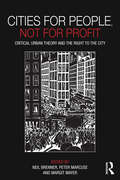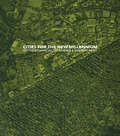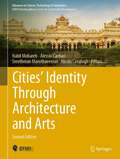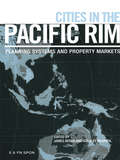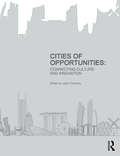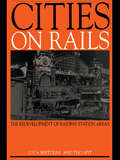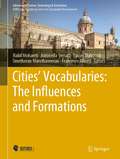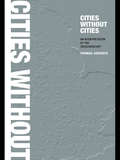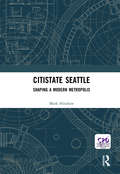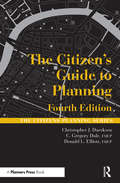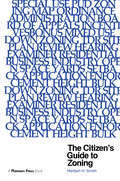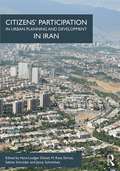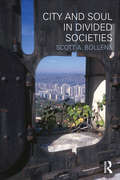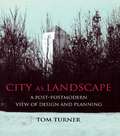- Table View
- List View
Cities for People, Not for Profit: Critical Urban Theory and the Right to the City
by Neil Brenner Peter Marcuse Margit MayerThe worldwide financial crisis has sent shock-waves of accelerated economic restructuring, regulatory reorganization and sociopolitical conflict through cities around the world. It has also given new impetus to the struggles of urban social movements emphasizing the injustice, destructiveness and unsustainability of capitalist forms of urbanization. This book contributes analyses intended to be useful for efforts to roll back contemporary profit-based forms of urbanization, and to promote alternative, radically democratic and sustainable forms of urbanism. The contributors provide cutting-edge analyses of contemporary urban restructuring, including the issues of neoliberalization, gentrification, colonization, "creative" cities, architecture and political power, sub-prime mortgage foreclosures and the ongoing struggles of "right to the city" movements. At the same time, the book explores the diverse interpretive frameworks – critical and otherwise – that are currently being used in academic discourse, in political struggles, and in everyday life to decipher contemporary urban transformations and contestations. The slogan, "cities for people, not for profit," sets into stark relief what the contributors view as a central political question involved in efforts, at once theoretical and practical, to address the global urban crises of our time. Drawing upon European and North American scholarship in sociology, politics, geography, urban planning and urban design, the book provides useful insights and perspectives for citizens, activists and intellectuals interested in exploring alternatives to contemporary forms of capitalist urbanization.
Cities for People, Not for Profit: Critical Urban Theory and the Right to the City
by Neil Brenner Peter Marcuse Margit MayerThe worldwide financial crisis has sent shock-waves of accelerated economic restructuring, regulatory reorganization and sociopolitical conflict through cities around the world. It has also given new impetus to the struggles of urban social movements emphasizing the injustice, destructiveness and unsustainability of capitalist forms of urbanization. This book contributes analyses intended to be useful for efforts to roll back contemporary profit-based forms of urbanization, and to promote alternative, radically democratic and sustainable forms of urbanism. The contributors provide cutting-edge analyses of contemporary urban restructuring, including the issues of neoliberalization, gentrification, colonization, "creative" cities, architecture and political power, sub-prime mortgage foreclosures and the ongoing struggles of "right to the city" movements. At the same time, the book explores the diverse interpretive frameworks – critical and otherwise – that are currently being used in academic discourse, in political struggles, and in everyday life to decipher contemporary urban transformations and contestations. The slogan, "cities for people, not for profit," sets into stark relief what the contributors view as a central political question involved in efforts, at once theoretical and practical, to address the global urban crises of our time. Drawing upon European and North American scholarship in sociology, politics, geography, urban planning and urban design, the book provides useful insights and perspectives for citizens, activists and intellectuals interested in exploring alternatives to contemporary forms of capitalist urbanization.
Cities for the New Millennium
by Marcial Echenique Andrew SaintCities for the New Millennium is the outcome of a joint conference held in Salford in July 2000 by the Royal Institute of British Architects and the University of Cambridge's Department of Architecture. It tackles these questions in the light of the Urban Task Force's report about the future of Britain's cities and communities, but sets them in an international and historical context. Professionals - architects, engineers and developers as well as academics from different countries and disciplines here lavish their expertise on issues of transportation, density, land use, risk and energy saving; others present urban-scale buildings or landscapes that have been judged inspirational or inventive. This book, therefore, is not just about theories of urbanism. It reveals how co-operation and debate between different parties and professions can illuminate the creative kind of urban development we should be aiming for.
Cities for the New Millennium
by Andrew Saint Marcial EcheniqueCities for the New Millennium is the outcome of a joint conference held in Salford in July 2000 by the Royal Institute of British Architects and the University of Cambridge's Department of Architecture. It tackles these questions in the light of the Urban Task Force's report about the future of Britain's cities and communities, but sets them in an international and historical context. Professionals - architects, engineers and developers as well as academics from different countries and disciplines here lavish their expertise on issues of transportation, density, land use, risk and energy saving; others present urban-scale buildings or landscapes that have been judged inspirational or inventive. This book, therefore, is not just about theories of urbanism. It reveals how co-operation and debate between different parties and professions can illuminate the creative kind of urban development we should be aiming for.
Cities’ Identity Through Architecture and Arts (Advances in Science, Technology & Innovation)
by Nabil Mohareb Alessio Cardaci Sreetheran Maruthaveeran Nicola CavalagliThis book presents works that book offer a novel interpretation of how today's urban problems can be tackled through the efficient use of resources and the modeling of solutions to best utilize the available features of cities. The second edition of this book compiles several research papers that present a detailed discussion of the formation and identification of cities and illustrate different case studies that deal with historical areas and buildings as part of preserving cities' vocabularies and self-identities. By unfolding a stimulating variety of topics in relation to the conservation of culture and identity, the book provides insights into planners and decision-makers, aiding them in their contributions to the implementation of the 2030 Sustainable Development goals with reference to heritage preservation.
Cities in the Pacific Rim
by James Berry Stanley McGrealThe cities of the Pacific Rim are in one of the most dynamic spheres of the global economy. In the twenty first century the focus of global affairs is destined to shift from the West to the East. These cities offer a wide range of different responses to the demands that rapid growth puts on planning and infrastructure : from the laxity that has lead to the urban sprawl of Bangkok to the regulation that is characteristic of Singapore. This book considers the interactive relationships between the operation of the planning system and the role and performance of property development and real estate markets in 14 Pacific Rim cities drawn from both the Eastern and Western perspective. The dynamic underlying these relationships considers the interplay between administrative structures, legislative controls and policy issues examining the role of actors and agencies in the property development and investment process.
Cities in the Pacific Rim: Planning Systems And Property Markets
by James Berry Stanley McGrealThe cities of the Pacific Rim are in one of the most dynamic spheres of the global economy. In the twenty first century the focus of global affairs is destined to shift from the West to the East. These cities offer a wide range of different responses to the demands that rapid growth puts on planning and infrastructure : from the laxity that has lead to the urban sprawl of Bangkok to the regulation that is characteristic of Singapore. This book considers the interactive relationships between the operation of the planning system and the role and performance of property development and real estate markets in 14 Pacific Rim cities drawn from both the Eastern and Western perspective. The dynamic underlying these relationships considers the interplay between administrative structures, legislative controls and policy issues examining the role of actors and agencies in the property development and investment process.
Cities of Opportunities: Connecting Culture and Innovation
by Jason PomeroyCulture refers to not only the arts but also other manifestations of human intellectual achievement regarded collectively. It similarly refers to the customs, institutions, and achievements of a social group, a people, or a nation. Innovation refers to the action or process of change, alteration, or revolution; a new method of idea creation or product that may bring about change. It is easy to assume that innovation may be juxtaposed to the preservation of culture and time-tested rituals. Yet as human settlements grew; and as streets and squares evolved through the diverse exchanges of people trading, celebrating, rallying and socially interacting, it should come as little surprise that cities and its places would become, and continue to be, centres of culture and innovation that can be inextricably linked. Culture and Innovation in cities can potentially take on different complexions if viewed through the lens of academics and practitioners drawn from different geographies, disciplines, or fields of expertise when addressing particular urban challenges. It is through this complexity of views that this book seeks to provide a broad perspective on culture and innovation in the context of global cities today; and a rich cornucopia of insights from thought leaders within their respective fields to shape the cities of tomorrow.
Cities of Opportunities: Connecting Culture and Innovation
by Jason PomeroyCulture refers to not only the arts but also other manifestations of human intellectual achievement regarded collectively. It similarly refers to the customs, institutions, and achievements of a social group, a people, or a nation. Innovation refers to the action or process of change, alteration, or revolution; a new method of idea creation or product that may bring about change. It is easy to assume that innovation may be juxtaposed to the preservation of culture and time-tested rituals. Yet as human settlements grew; and as streets and squares evolved through the diverse exchanges of people trading, celebrating, rallying and socially interacting, it should come as little surprise that cities and its places would become, and continue to be, centres of culture and innovation that can be inextricably linked. Culture and Innovation in cities can potentially take on different complexions if viewed through the lens of academics and practitioners drawn from different geographies, disciplines, or fields of expertise when addressing particular urban challenges. It is through this complexity of views that this book seeks to provide a broad perspective on culture and innovation in the context of global cities today; and a rich cornucopia of insights from thought leaders within their respective fields to shape the cities of tomorrow.
Cities on Rails: The Redevelopment of Railway Stations and their Surroundings
by Luca Bertolini Tejo SpitThe development of railway stations and their surroundings is an emerging feature in current urban projects. Based on a series of the most inspiring contemporary European examples of station redevelopment, this book will help planners and urban designers understand the specific and complex nature of station locations. Based on their extensive research, the authors, pioneers of studies in the field in the last few years, harness and expand the body of knowledge and present guiding principles and conditions for successful implementation of such planning projects.
Cities’ Vocabularies: The Influences and Formations (Advances in Science, Technology & Innovation)
by Nabil Mohareb Antonella Versaci Yasser Mahgoub Sreetheran Maruthaveeran Francesco AlbertiThis book discusses several topics regarding different vocabularies, such as sacred architecture, heritage buildings, open spaces, landmarks, and street escapes, all of which have a direct influence on the city form. The city form is also affected by the indirect impact of the citizens themselves, for example their culture, which in turn depends on the arts, as can be seen and embodied in morals, paintings, media, digital art, and sculpture. The book also examines the fundamental elements that are responsible for the identity of the city. Presenting case studies that demonstrate the how implementing the concept of the responsibility of architecture and arts affects the development of our cities, the book offers a new approach that is based on the available features of a city and explores how planners and decision-makers can use these features to address the myriad problems that our cities are facing.
Cities Without Cities: An Interpretation of the Zwischenstadt
by Thomas SievertsThis book investigates the characteristics of today's built environment: no longer simply a city but increasingly large conurbations made up of a number of development clusters, linked by transport routes. The diffusion of the once compact city into a city web, the 'meta city' is mirrored by changes in society from communities with strong social cohesion and interest in their towns and cities to individuals pursing their own goals, with global social links and little interest in their city.
Cities Without Cities: An Interpretation of the Zwischenstadt
by Thomas SievertsThis book investigates the characteristics of today's built environment: no longer simply a city but increasingly large conurbations made up of a number of development clusters, linked by transport routes. The diffusion of the once compact city into a city web, the 'meta city' is mirrored by changes in society from communities with strong social cohesion and interest in their towns and cities to individuals pursing their own goals, with global social links and little interest in their city.
Citistate Seattle: Shaping A Modern Metropolis
by Mark HinshawWith style and humor, the author writes of special places in everyday Seattle. The author takes us to popular, high-profile landmarks like Pike Place Market as well as tucked-away gems — cozy cottages, trendy pubs, gracious apartment buildings, and vibrant urban villages — that flavor and enliven the city. The author shares his eye for unique, humanizing details of design, architecture, and function, bringing this colorful metropolis to life so vividly you'll practically smell the coffee they brew and sell on (almost) every street corner. Along the way, the author explains the public and private decisions that helped Seattle avoid the urban desolation that plagues other American cities. The author introduces many of Seattle's movers and shakers — mayors, developers, artists, and urban pioneers — who took it upon themselves to guide metropolitan Seattle along a different path.
Citistate Seattle: Shaping A Modern Metropolis
by Mark HinshawWith style and humor, the author writes of special places in everyday Seattle. The author takes us to popular, high-profile landmarks like Pike Place Market as well as tucked-away gems — cozy cottages, trendy pubs, gracious apartment buildings, and vibrant urban villages — that flavor and enliven the city. The author shares his eye for unique, humanizing details of design, architecture, and function, bringing this colorful metropolis to life so vividly you'll practically smell the coffee they brew and sell on (almost) every street corner. Along the way, the author explains the public and private decisions that helped Seattle avoid the urban desolation that plagues other American cities. The author introduces many of Seattle's movers and shakers — mayors, developers, artists, and urban pioneers — who took it upon themselves to guide metropolitan Seattle along a different path.
The Citizen's Guide to Planning
by Christopher Duerksen Gregory C Dale Donald L ElliottAPA's popular primer for citizens is all new! For decades, planning officials and engaged citizens have relied on this book for a better understanding of the basics of planning. Now the authors have revised this perennial bestseller into a 21st-century guide for anyone who wants to make his or her community a better place. This book describes the land-use planning process, the key players in that process, and the legal framework in which decisions are made. The authors advocate principles and disciplines that will help those involved in the process make good decisions. In easy-to-understand language, they offer nuts-and-bolts information about different types of plans and how they are implemented. Chapters cover the goals and values of planning, the history of planning, the different people and organizations involved, the creation and implementation of a comprehensive plan, sustainability, the application review process, and legal and ethical questions.
The Citizen's Guide to Planning
by Christopher Duerksen Gregory C Dale Donald L ElliottAPA's popular primer for citizens is all new! For decades, planning officials and engaged citizens have relied on this book for a better understanding of the basics of planning. Now the authors have revised this perennial bestseller into a 21st-century guide for anyone who wants to make his or her community a better place. This book describes the land-use planning process, the key players in that process, and the legal framework in which decisions are made. The authors advocate principles and disciplines that will help those involved in the process make good decisions. In easy-to-understand language, they offer nuts-and-bolts information about different types of plans and how they are implemented. Chapters cover the goals and values of planning, the history of planning, the different people and organizations involved, the creation and implementation of a comprehensive plan, sustainability, the application review process, and legal and ethical questions.
Citizen's Guide to Zoning
by Herbert SmithFirst published in 1983. Routledge is an imprint of Taylor & Francis, an informa company. An easy-to-read book about zoning that cuts the jargon out but leaves the wisdom in. Smith explains the fundamental principles of zoning, how to develop zoning regulations, and the nuts and bolts of a zoning ordinance. He examines variances, zoning hearings, and frequent zoning problems.
Citizen's Guide to Zoning
by Herbert SmithFirst published in 1983. Routledge is an imprint of Taylor & Francis, an informa company. An easy-to-read book about zoning that cuts the jargon out but leaves the wisdom in. Smith explains the fundamental principles of zoning, how to develop zoning regulations, and the nuts and bolts of a zoning ordinance. He examines variances, zoning hearings, and frequent zoning problems.
Citizens' Participation in Urban Planning and Development in Iran
by Hans-Liudger Dienel M. Reza Shirazi Sabine Schröder Jenny SchmithalsDuring recent years, the topic of participation has increasingly been gaining importance in Iran – in the scientific field, in practice and rhetoric. However, in current scientific literature – and especially in English literature – there is little knowledge on the conditions, legal background, perceptions, experiences and processes of citizens’ participation in Iran. This book aims to shed light on the paradoxical question of participation in Iran: it is old and new, dysfunctioning and functioning, disappointing and promising. This slippery status of participation convinces scholars to suggest contradictory interpretations and understandings about the existence, functionality, and potentiality of this concept. The book therefore shows the different perspectives, interpretations, historical developments and case studies of participation in Iran, thus giving the reader a kaleidoscope view on the question of participation in Iran.
Citizens' Participation in Urban Planning and Development in Iran
by Dienel HansLiudgerDuring recent years, the topic of participation has increasingly been gaining importance in Iran – in the scientific field, in practice and rhetoric. However, in current scientific literature – and especially in English literature – there is little knowledge on the conditions, legal background, perceptions, experiences and processes of citizens’ participation in Iran. This book aims to shed light on the paradoxical question of participation in Iran: it is old and new, dysfunctioning and functioning, disappointing and promising. This slippery status of participation convinces scholars to suggest contradictory interpretations and understandings about the existence, functionality, and potentiality of this concept. The book therefore shows the different perspectives, interpretations, historical developments and case studies of participation in Iran, thus giving the reader a kaleidoscope view on the question of participation in Iran.
City and Soul in Divided Societies (Planning, History and Environment Series)
by Scott A. BollensIn this unique book Scott A. Bollens combines personal narrative with academic analysis in telling the story of inflammatory nationalistic and ethnic conflict in nine cities – Jerusalem, Beirut, Belfast, Johannesburg, Nicosia, Sarajevo, Mostar, Bilbao, and Barcelona. Reporting on seventeen years of research and over 240 interviews with political leaders, planners, architects, community representatives, and academics, he blends personal reflections, reportage from a wealth of original interviews, and the presentation of hard data in a multidimensional and interdisciplinary exploration of these urban environments of damage, trauma, healing, and repair. City and Soul in Divided Societies reveals what it is like living and working in these cities, going inside the head of the researcher. This approach extends the reader’s understanding of these places and connects more intimately with the lived urban experience. Bollens observes that a city disabled by nationalistic strife looks like a callous landscape of securitized space, divisions and wounds, frozen in time and in place. Yet, the soul in these cities perseveres. Written for general readers and academic specialists alike, City and Soul in Divided Societies integrates facts, opinions, photographs, and observations in original ways in order to illuminate the substantial challenges of living in, and governing, polarized and unsettled cities.
City and Soul in Divided Societies (Planning, History and Environment Series)
by Scott A. BollensIn this unique book Scott A. Bollens combines personal narrative with academic analysis in telling the story of inflammatory nationalistic and ethnic conflict in nine cities – Jerusalem, Beirut, Belfast, Johannesburg, Nicosia, Sarajevo, Mostar, Bilbao, and Barcelona. Reporting on seventeen years of research and over 240 interviews with political leaders, planners, architects, community representatives, and academics, he blends personal reflections, reportage from a wealth of original interviews, and the presentation of hard data in a multidimensional and interdisciplinary exploration of these urban environments of damage, trauma, healing, and repair. City and Soul in Divided Societies reveals what it is like living and working in these cities, going inside the head of the researcher. This approach extends the reader’s understanding of these places and connects more intimately with the lived urban experience. Bollens observes that a city disabled by nationalistic strife looks like a callous landscape of securitized space, divisions and wounds, frozen in time and in place. Yet, the soul in these cities perseveres. Written for general readers and academic specialists alike, City and Soul in Divided Societies integrates facts, opinions, photographs, and observations in original ways in order to illuminate the substantial challenges of living in, and governing, polarized and unsettled cities.
City as Landscape: A Post Post-Modern View of Design and Planning
by Tom TurnerIn twenty essays, this book covers aspects of planning, architecture, urban design, landscape architecture, park and garden design. Their approach, described as post-postmodern, is a challenge to the 'anything goes' eclecticism of the merely postmodern.
City as Landscape: A Post Post-Modern View of Design and Planning
by Tom TurnerIn twenty essays, this book covers aspects of planning, architecture, urban design, landscape architecture, park and garden design. Their approach, described as post-postmodern, is a challenge to the 'anything goes' eclecticism of the merely postmodern.
